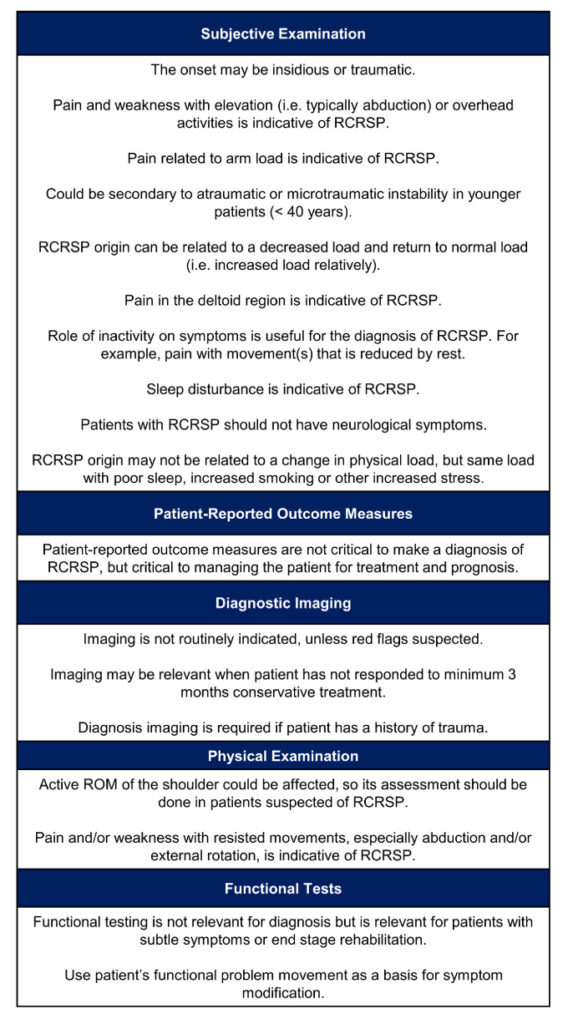Introduction
Shoulder pain is one of the most common conditions in physical therapy, occupational therapy, chiropractic, medicine, and athletic training. It is often diagnosed as impingement syndrome, tendinopathy, subacromial bursitis, or a partial rotator cuff tear. Shoulder pain has a point prevalence of 7% to 26% and a lifetime prevalence of around 67%, depending upon the criteria used for the diagnosis [1]. In the US, the direct costs for the management of shoulder pain reached $7 billion in 2000 [2]. In 2015–2016, there were 35,000 hospitalizations for shoulder pain in Australia [3]. The most common shoulder surgical procedures were arthroplasty rotator cuff repair with decompression of the subacromial space and arthroscopic stabilization [4].
In 1972, Dr. Charles Neer, an orthopedic surgeon at the Columbia University Medical Center, first suggested that changes in the acromion could result from repeated contact with the proximal part of the humerus and the rotator cuff [5]. In 1983, Neer confirmed that impingement of the rotator cuff against the acromion would cause most shoulder dysfunctions [6]. During the next 40 years, impingement surgery became one of the most performed orthopedic surgeries. In the year 2,000, subacromial decompression was performed on 2,523 patients in the UK compared to 21,355 in 2010 [7].
The American Orthopaedic Association recognized Dr. Neer as a “Pillar of the Orthopaedic Profession” for his contributions to shoulder and elbow surgery. Noteworthy is that he performed this impingement syndrome surgery only ten times per year [8].
The Case Against Surgery

In 2011, a group of orthopedic surgeons expressed the difficulty of reliably differentiating the various subgroups of impingement syndrome, including rotator cuff disorders, rotator cuff tendinosis, partial tears, and complete tears [8]. They suggested that “it may be time to replace the nonspecific diagnosis of so-called impingement syndrome by using modern methods to differentiate tendinosis, partial tears, and complete tears of the rotator cuff.” In a Letter-to-the-Editor, Bron, Staal, and Dommerholt confirmed that no scientific evidence supports the impingement syndrome hypothesis [9]. They commented that
“Scientific studies characterizing rotator cuff disorders and the results of treatment of different rotator cuff abnormalities must include advanced imaging, such as sonography or MRI, or arthroscopy. These diagnostic modalities can examine for abnormalities in bone, cartilage, tendons and bursae and help to diagnose for bursitis, tendinitis, tendinopathy, partial and full thickness tendon tears.
But, as we know from several studies, many of these changes are seen as often in asymptomatic shoulders as in patients with shoulder pain. Kahn found a lack of evidence that pain is related to the inflammation of tendons [10]. Signs of inflammation on MRI and sonography, including fluid in the subacromial bursae and the glenohumeral joint are also shown in asymptomatic shoulders [11-13]. Most rotator cuff tears are part of a natural degenerative process of the shoulder and are not necessarily related to shoulder pain [14, 15].”
In 2014, a group of Dutch orthopedic surgeons and a physical therapist published a guideline for diagnosing and treating subacromial pain syndrome based on a multidisciplinary review of the scientific literature by the Dutch Orthopaedic Association [16]. According to this guideline, the anatomy-based impingement concept is insufficient and should be replaced with the more appropriate term “Sub-Acromial Pain Syndrome” or SAPS [16]. They recommended against surgery [16].
A 2018 multicenter, randomized, pragmatic, parallel-group, placebo-controlled, three-group trial with 51 surgeons at 32 hospitals in the UK questioned whether surgical decompression was any better than arthroscopy only. The researchers suggested that apparent improvements could have been due to placebo or post-surgical physical therapy [17].
Also in 2018, the Finnish Subacromial Impingement Arthroscopy Controlled Trial (FIMPACT) concluded that patients who had shoulder impingement syndrome were no better than patients who were part of a placebo group that did not get surgery [18]. Patients in both groups were equally satisfied with their shoulder and the amount of shoulder pain [18]. In a five-year follow-up study examining the long-term effects of arthroscopic subacromial decompression (ASD), the authors concluded that surgery provided no benefit over diagnostic arthroscopy or exercise therapy [19]. A study looking into the cost-effectiveness, use of resources, costs, and quality of life outcomes concluded that the evidence for cost-effectiveness at 12 months was also inconclusive [20].
Even though current guidelines developed by expert panels strongly recommend against surgery for SAPS [16, 21, 22], it is not difficult to find websites of orthopedic surgeons that continue stating that “….shoulder impingement is a common cause of anywhere from 45 to 65 percent of all shoulder pain cases….” as a reason to perform subacromial decompression surgery, especially for persistent shoulder pain, failed previous treatments, or in the presence of other shoulder injuries. Physical therapists often see patients who were assured by their orthopedic surgeons that surgery is inevitable, which can make it challenging to convince them to try physical therapy and, especially dry needling.
Rotator Cuff Related Shoulder Pain
 Others have suggested using the term “rotator cuff-related shoulder pain” (RCRSP), which would encompass SAPS, rotator cuff tendinopathy, symptomatic partial and full-thickness rotator cuff tears, and subacromial bursitis [23]. Recognizing the lack of standardized criteria for diagnosing RCRSP, participants in a 2022 Delphi study agreed upon 18 clinical descriptors across six domains [24]. The term “rotator cuff related shoulder pain” may assist patients gain a better understanding of their symptoms of shoulder pain and weakness [25]. The diagnostic descriptor confirms that the etiology is generally unknown [26]. Patients commonly present with a history of increased physiological load before they experience symptoms or a decreased ability to deal with physiological load [25]. There is some controversy about whether exercise is helpful for patients with RCRSP [27, 28]. A scoping review of the dosage of joint mobilization found limited information about the dosage or the rationale for selecting joint mobilization [29].
Others have suggested using the term “rotator cuff-related shoulder pain” (RCRSP), which would encompass SAPS, rotator cuff tendinopathy, symptomatic partial and full-thickness rotator cuff tears, and subacromial bursitis [23]. Recognizing the lack of standardized criteria for diagnosing RCRSP, participants in a 2022 Delphi study agreed upon 18 clinical descriptors across six domains [24]. The term “rotator cuff related shoulder pain” may assist patients gain a better understanding of their symptoms of shoulder pain and weakness [25]. The diagnostic descriptor confirms that the etiology is generally unknown [26]. Patients commonly present with a history of increased physiological load before they experience symptoms or a decreased ability to deal with physiological load [25]. There is some controversy about whether exercise is helpful for patients with RCRSP [27, 28]. A scoping review of the dosage of joint mobilization found limited information about the dosage or the rationale for selecting joint mobilization [29].
Dry Needling for SAPS and RCRSP
Although the various guidelines did not mention dry needling as an effective treatment option for SAPS and RCRSP, several recent systematic reviews support its use. Navarro-Santana and colleagues concluded in their 2020 systematic review and meta-analysis that there was “moderate- to low-quality evidence suggests positive effects of TrP dry needling for pain intensity (small effect) and pain-related disability (large effect) in nontraumatic shoulder pain of musculoskeletal origin [30]. Six trials were included out of an initial 551
Griswold and colleagues searched six databases (PubMED, CINAHL, Biosis, Web of Science, SPORTDiscus, and Cochrane Central Register of Controlled Trials), and identified eight studies of dry needling for SAPS (n=538) [31]. The researchers concluded that “dry needling performed in combination with other conservative interventions produced favorable outcomes at all time points for pain and disability” in patients with SAPS [31]. More research is needed to determine whether dry needling as a single intervention would be superior to other interventions.
Para-García and colleagues were a bit more cautious in the conclusions of their systematic review and meta-analysis of dry needling alone or in combination with exercise therapy versus other interventions [32]. They searched IBECs, PUBMED, CENTRAL, Web of Science Core Collection, and Scopus. The meta-analysis and qualitative analysis included five randomized controlled trials (n = 315). They concluded that there was low-quality evidence that dry needling alone or combined with exercise therapy showed improvements in pain in the short-term and mid-term compared to a range of interventions, however, the effect of dry needling on disability was very uncertain [32].
In a 2022 systematic review of the effectiveness of dry needling in SAPS, Blanco-Díaz and colleagues included 94 studies (n=402) comparing the application of conventional physiotherapy to dry needling, either in a combination or in isolation [33]. They concluded that “dry needling is effective and safe in reducing the pain and disability produced by SAPS, with the best combination of treatment turning out to be conventional physiotherapy together with DN, obtaining more stable and longer-lasting benefits than merely applying the techniques in isolation” [33].
Furthermore, dry needling in an exercise program was more cost-effective for patients with SAPS than exercise alone [34].
Summary
During the Myopain Seminars Dry Needling courses, students learn in-depth and up-to-date information about musculoskeletal pain and dysfunction, including shoulder pain. We review some of the issues with diagnoses such as impingement syndrome, frozen shoulder, trochanteric bursitis, or plantar fasciitis. This blog summarizes several essential studies refuting the concept of impingement syndrome in favor of SAPS. Four systematic reviews and three meta-analyses support using dry needling in patients with SAPS, usually combined with other interventions.
The Obvious Choice for Dry Needling Education
Dry Needling Course Series

The Dry Needling 1 course is an excellent starting point for learning the fundamentals of dry needling therapy. With a focus on the safe and effective application of dry needling techniques, you will gain a solid understanding of myofascial trigger points, needling techniques, precautions, and how to apply these techniques in clinical practice.

The Dry Needling 2 course is an intermediate-level course that provides in-depth knowledge and hands-on training for dry needling techniques of the extremities, including the upper and lower body. By completing this course, you will expand upon the skills you acquired in the DN-1 course and better understand the application of dry needling for managing musculoskeletal pain and dysfunction.

The Dry Needling 3 course is the final course in the series and the last step before becoming a Certified Myofascial Trigger Point Therapist – Dry Needling (CMTPT/DN). This course offers an in-depth study of advanced dry needling techniques for hand muscles, several lower extremity and foot muscles, the craniofacial and craniomandibular muscles, and more.
References
- Luime, J.J., et al., Prevalence and incidence of shoulder pain in the general population; a systematic review. Scand J Rheumatol, 2004. 33(2): p. 73-81. https://doi.org/10.1080/03009740310004667
- Meislin, R.J., J.W. Sperling, and T.P. Stitik, Persistent shoulder pain: epidemiology, pathophysiology, and diagnosis. Am J Orthop (Belle Mead NJ), 2005. 34(12 Suppl): p. 5-9. https://pubmed.ncbi.nlm.nih.gov/16450690/
- Australian Insitute of Health and Welfare. Procedures and healthcare interventions. ninth ed. ACHI; 2017 Retrieved from https://www.aihw.gov.au/reports/hospitals/procedures-data-cubes/contents/data-cubes
- Hodgetts, C. and B. Walker, Epidemiology, common diagnoses, treatments and prognosis of shoulder pain: A narrative review. International Journal of Osteopathic Medicine, 2021. 42: p. 11-19. https://doi.org/10.1016/j.ijosm.2021.10.006
- Neer, C.S., 2nd, Anterior acromioplasty for the chronic impingement syndrome in the shoulder: a preliminary report. J Bone Joint Surg Am, 1972. 54(1): p. 41-50. https://pubmed.ncbi.nlm.nih.gov/5054450/
- Neer, C.S., 2nd, Impingement lesions. Clin Orthop Relat Res, 1983. 173(173): p. 70-7. https://pubmed.ncbi.nlm.nih.gov/6
- Judge, A., et al., Temporal trends and geographical variation in the use of subacromial decompression and rotator cuff repair of the shoulder in England. Bone Joint J, 2014. 96-b(1): p. 70-4. https://doi.org/10.1302/0301-620X.96B1.32556
- Papadonikolakis, A., et al., Published evidence relevant to the diagnosis of impingement syndrome of the shoulder. J Bone Joint Surg Am, 2011. 93(19): p. 1827-32. https://doi.org/10.2106/JBJS.J.01748
- Bron, C., J.B. Staal, and J. Dommerholt, Comment on Published Evidence Relevant to the Diagnosis of Impingement Syndrome of the Shoulder. The Journal of Bone & Joint Surgery,, 2011.
- Khan, K.M., et al., Time to abandon the “tendinitis” myth. BMJ, 2002. 324(7338): p. 626-7. https://doi.org/10.1136/bmj.324.7338.626
- Connor, P.M., et al., Magnetic resonance imaging of the asymptomatic shoulder of overhead athletes: a 5-year follow-up study. Am J Sports Med, 2003. 31(5): p. 724-7. https://doi.org/10.1177/03635465030310051501
- Girish, G., et al., Ultrasound of the shoulder: asymptomatic findings in men. AJR Am J Roentgenol, 2011. 197(4): p. W713-9. https://doi.org/10.2214/AJR.11.6971
- Miniaci, A., et al., Magnetic resonance imaging of the shoulder in asymptomatic professional baseball pitchers. Am J Sports Med, 2002. 30(1): p. 66-73. https://doi.org/10.1177/03635465020300012501
- Milgrom, C., et al., Rotator-cuff changes in asymptomatic adults. The effect of age, hand dominance and gender. J Bone Joint Surg Br, 1995. 77(2): p. 296-8.
- Schibany, N., et al., Rotator cuff tears in asymptomatic individuals: a clinical and ultrasonographic screening study. Eur J Radiol, 2004. 51(3): p. 263-8. https://doi.org/10.1016/S0720-048X(03)00159-1
- Diercks, R., et al., Guideline for diagnosis and treatment of subacromial pain syndrome. A multidisciplinary review by the Dutch Orthopaedic Association. Acta Orthopaedica, 2014. 85(3): p. 314–322. https://doi.org/10.3109/17453674.2014.920991
- Beard, D.J., et al., Arthroscopic subacromial decompression for subacromial shoulder pain (CSAW): a multicentre, pragmatic, parallel group, placebo-controlled, three-group, randomised surgical trial. Lancet, 2018. 391(10118): p. 329-338. https://doi.org/10.1016/S0140-6736(17)32457-1
- Paavola, M., et al., Subacromial decompression versus diagnostic arthroscopy for shoulder impingement: randomised, placebo surgery controlled clinical trial. Bmj, 2018. 362: p. k2860. https://doi.org/10.1136/bmj.k2860
- Paavola, M., et al., Subacromial decompression versus diagnostic arthroscopy for shoulder impingement: a 5-year follow-up of a randomised, placebo surgery controlled clinical trial. Br J Sports Med, 2021. 55(2): p. 99-107. https://doi.org/10.1136/bjsports-2020-102216
- Rombach, I., et al., Cost-effectiveness analysis of a placebo-controlled randomized trial evaluating the effectiveness of arthroscopic subacromial decompression in patients with subacromial shoulder pain. Bone Joint J, 2019. 101-b(1): p. 55-62. https://doi.org/10.1302/0301-620X.101B1.BJJ-2018-0555.R1
- Vandvik, P.O., et al., Subacromial decompression surgery for adults with shoulder pain: a clinical practice guideline. Bmj, 2019. 364: p. l294. https://doi.org/10.1136/bmj.l294
- Reischl, S. and J.C. MacDermid, Appraisal of Clinical Practice Guideline: Subacromial decompression surgery for adults with shoulder pain. J Physiother, 2020. 66(3): p. 201. https://doi.org/10.1016/j.jphys.2020.05.008
- Lewis, J., Rotator cuff related shoulder pain: Assessment, management and uncertainties. Manual Therapy, 2016. 23: p. 57-68. https://doi.org/10.1016/j.math.2016.03.009
- Requejo-Salinas, N., et al., International physical therapists consensus on clinical descriptors for diagnosing rotator cuff related shoulder pain: A Delphi study. Braz J Phys Ther, 2022. 26(2): p. 100395. https://doi.org/10.1016/j.bjpt.2022.100395
- Lo, C.N., H. Van Griensven, and J. Lewis, Rotator cuff related shoulder pain: An update of potential pathoaetiological factors. New Zealand Journal of Physiotherapy, 2023. 50(2): p. 82-93. https://dx.doi.org/10.15619/nzjp/50.2.05
- Manoso-Hernando, D., et al., Shoulder mobility and strength impairments in patients with rotator cuff related shoulder pain: a systematic review and meta analysis. PeerJ, 2024. 12: p. e17604. https://doi.org/10.7717/peerj.17604
- Powell, J.K., et al., Is exercise therapy the right treatment for rotator cuff-related shoulder pain? Uncertainties, theory, and practice. Musculoskeletal Care, 2024. 22(2): p. e1879. https://doi.org/10.1002/msc.1879
- Dubé, M.O., et al., FITT Odyssey: A Scoping Review of Exercise Programs for Managing Rotator Cuff Related Shoulder Pain. J Orthop Sports Phys Ther, 2024: p. 1-45. https://doi.org/10.2519/jospt.2024.12452
- Wang, S., et al., Dosage of joint mobilization for the management of patients with rotator cuff-related shoulder pain: A scoping review. Musculoskelet Sci Pract, 2024. 70: p. 102903. https://doi.org/10.1016/j.msksp.2023.102903
- Navarro-Santana, M.J., et al., Effects of Trigger Point Dry Needling for Nontraumatic Shoulder Pain of Musculoskeletal Origin: A Systematic Review and Meta-Analysis. Physical Therapy, 2021. 101(2): p. pzaa216. https://doi.org/10.1093/ptj/pzaa216
- Griswold, D., et al., Dry Needling for Subacromial Pain Syndrome. A Systematic Review with Meta-analysis. Pain Med, 2022. https://doi.org/10.1093/pm/pnac131
- Para-Garcia, G., et al., Dry Needling Alone or in Combination with Exercise Therapy versus Other Interventions for Reducing Pain and Disability in Subacromial Pain Syndrome: A Systematic Review and Meta-Analysis. Int J Environ Res Public Health, 2022. 19(17). https://doi.org/10.3390/ijerph191710961
- Blanco-Díaz, M., et al., A Systematic Review of the Effectiveness of Dry Needling in Subacromial Syndrome. Biology, 2022. 11(2): p. 243. https://doi.org/10.3390/biology11020243
- Arias-Buria, J. L., Martin-Saborido, C., Cleland, J., Koppenhaver, S. L., Plaza-Manzano, G., & Fernandez-de-Las-Penas, C. (2018). Cost-effectiveness Evaluation of the Inclusion of Dry Needling into an Exercise Program for Subacromial Pain Syndrome: Evidence from a Randomized Clinical Trial. Pain Med. https://doi.org/10.1093/pm/pny021
Photo by Luiz Rogério Nunes on Unsplash

